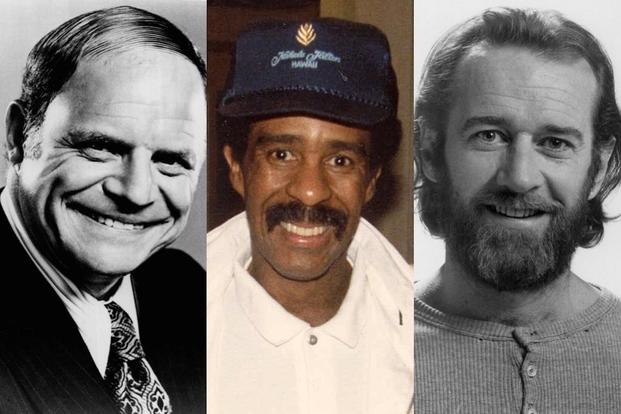Every military unit has at least one person who can crack a joke about anything at any time. Most of those people learn discipline, grow up and become productive members of society.
A surprising number of them never really get over that hump, so they go on the road and try to tell jokes for a living. Any look into the history of comedy reveals dozens of World War II veterans who made a career out of being funny in the 1950s and ’60s.
Every generation since has produced a few more successful jokesters, and a few of them, such as Rob Riggle and Fred Willard, have gone on to even great fame as go-to actors in comedy movies and shows.
Heading out on stage armed only with a microphone and your own wits should be a terrifying experience, but the masters of the art make it look easy. Here are 11 of the most successful veteran comics.
Don Rickles
Rickles enlisted in the Navy during World War II and served as a seaman first class on the motor torpedo boat tender USS Cyrene in the Pacific. “It was so hot and humid, the crew rotted,” he later observed about his wartime experience.
After Rickles was discharged, he struggled to become a dramatic actor and started doing stand-up comedy for the paycheck. That didn’t go particularly well, either, until he found his niche by humiliating hecklers and insulting the audience. As king of the insult comics, Rickles became a beloved show business figure before his death in 2017.
Don’s Navy sitcom, “CPO Sharkey,” and several of his stand-up specials are now available for streaming at the Shout! Factory TV website or via their apps for Roku, Apple TV, Amazon Fire and Android TV.
George Carlin
Carlin joined the Air Force in 1954 after he dropped out of high school. While stationed at Barksdale Air Force Base in Bossier City, Louisiana, he got a job as a disc jockey at radio station KJOE across the Red River in Shreveport. That gig, combined with his bad attitude, led to his discharge after three years of service.
Carlin enjoyed early success as a clean-cut comedian, appearing several times on “The Tonight Show.’’ Once he dropped LSD, he changed his entire approach. Carlin grew his hair long, got his ear pierced and started mixing in routines about drugs and profanity into his more traditional observational comedy.
His comedy albums were massive hits, and Carlin became one of the most successful acts of the 1970s. He walked away from live performance at his career peak in 1976, although he returned to the stage later in life. Carlin died in 2008.
Carl Reiner & Mel Brooks
Reiner was drafted into the Army in 1942, and after initially training as a radio operator, he eventually found his way into the Special Services entertainment unit and spent the rest of the war performing for troops in the Pacific theater.
Brooks was drafted in 1944 and was trained to defuse landmines. He fought in the Battle of the Bulge and served with the 1104th Engineer Combat Battalion, 78th Infantry Division as the Allies invaded Germany.
Reiner and Brooks met as writers on fellow WWII veteran Sid Caesar’s NBC series, “Your Show of Shows.” The two writers began performing a routine with Reiner as a television interviewer and Brooks as a man who claimed to be 2,000 years old. The act took off, and the duo appeared onstage and on television and released comedy albums.
Both men enjoyed long careers as writers, actors and directors. Reiner created “The Dick Van Dyke Show’’ and directed Steve Martin in “The Jerk.” Brooks wrote and directed classics, such as “Blazing Saddles,” “Young Frankenstein” and “High Anxiety.”
Reiner died in 2020 at age 98, friends with Brooks until the end. Brooks is still with us at age 94.
Lenny Bruce
Bruce dropped out of high school and joined the Navy at age 16 in 1942. He served aboard the USS Brooklyn in the Mediterranean Sea before receiving a dishonorable discharge after he performed a comedy routine in drag for his shipmates and convinced the ship’s doctor that he was experiencing “homosexual urges.”
Bruce made his name doing material that was considered “obscene” by police forces all over the country but now wouldn’t raise an eyebrow. He was arrested multiple times for drug possession and obscenity onstage. He was convicted on obscenity charges in New York City after a six-month trial in 1964. Bruce died of a heroin overdose in 1966.
The comic’s act was most definitely not appropriate for television, but host Steve Allen was such a big fan that he helped Bruce get past the network censors and perform on his show.
Jonathan Winters
Winters dropped out of high school in 1942 to join the Marine Corps. He served two-and-a-half years in the Pacific Theater, notably on board the aircraft carrier USS Bonhomme Richard off the coast of Japan in 1945. He was also in the occupation force at Yokosuka.
Winters was one of the most inventive comics of the 1950s, performing wild shows that were often master classes in improvisation. He became a regular on the first generation of late-night talk shows and released a series of successful comedy albums.
The comedian walked away from live stand-up in 1961, but he influenced a generation of comics (most notably Robin Williams) through another five decades of television and movie performances. Winters, 87, died in 2013.
Richard Pryor
Pryor served in the Army from 1959-1960, but the story is that he spent most of his service in a military prison in West Germany after beating up a White soldier who made racial jokes during a screening of the controversial 1950s drama movie “Imitation of Life.”
Pryor kicked around as a struggling stand-up and television writer for the next decade, but his career took off after he appeared at the Wattstax concert in 1972 and released a series of hugely successful comedy albums. He became one of the biggest movie stars of his generation in films like “Uptown Saturday Night,” “Silver Streak” and “Stir Crazy,” appearing in the last two movies alongside Army veteran Gene Wilder.
His profitable concert films brought stand-up comedy to theater audiences worldwide. Pryor was diagnosed with multiple sclerosis in the early 1990s and died in 2005.
Jerry Stiller
Stiller was drafted into the Army during the final days of World War II and served in Europe.
He convinced his wife, Anne Meara, to form a comedy team in the mid-1950s, and the duo broke through in nightclubs and on television in the ’60s. They quit the live performance circuit and made a career with radio commercials for Blue Nun wine in the ’70s and starred in their own sitcom in 1986. Jerry also fathered Ben Stiller with Meara, so the kid remains one of their most successful collaborations.
Stiller went on to play two of the greatest irate father characters in sitcom history, Frank Costanza on “Seinfeld” and Arthur Spooner on “The King of Queens.” Stiller died in 2020.
Bob Newhart
Newhart was drafted into the Army in 1952 after his graduation from Loyola University of Chicago. He served in the Korean War as a personnel manager until his discharge in 1954.
Newhart was an advertising copywriter who amused his co-workers with one-sided telephone conversations. He recorded a few of them and used them as radio-station audition tapes. That led to a radio gig, and a meeting with a Warner Bros. Records executive led to a recording contract before he’d ever performed a live gig.
Newhart eventually developed stage chops, and his albums were a sensation. He even won a Grammy award for Album of the Year in 1961. He later went on to star in “The Bob Newhart Show” and “Newhart,” two of the most successful sitcoms of all time. He later appeared as the adoptive father of Buddy in “Elf,” and he’s still with us at age 91.
Drew Carey
After dropping out of Kent State University, Carey joined the Marine Corps Reserve in 1980. He served for six years as a radio operator in the 25th Marine Regiment in Ohio. “The Marines gave me a really strong sense of discipline and a work ethic that kicks in at my job,” Carey told ESPN. “I think that attitude comes from my Marine days.”
He had a fast career rise in the clubs, making his first appearance on “The Tonight Show” in 1991. Less than four years later, he was starring in the sitcom, “The Drew Carey Show.”
Carey went on to host the popular improv comedy series “Whose Line Is It Anyway?” and eventually landed a sweet gig in 2007 as Bob Barker’s replacement on “The Price Is Right.”
Nipsey Russell
Julius “Nipsey” Russell enlisted in the U.S. Army in June 1941 and served as a medic in Europe during World War II, returning home to Atlanta as a second lieutenant.
He got his start in comedy while working as a carhop at Atlanta’s legendary drive-in restaurant, The Varsity, which is still in business serving its world-class chili dogs and onion rings. He made customers laugh, and they upped his tips. He later took his act into local nightclubs, and things took off from there.
Russell made his first national television appearance on “The Ed Sullivan Show’’ in 1967 and made dozens of appearances while also taking on a supporting role on the sitcom, “Car 54, Where Are You?” While he was one of the first Black comedians to cross over to White audiences in the era, he also was outspoken about the pay disparity between Black and White comics during the era.
Russell made a lasting impression in the ’70s and ’80s as a celebrity panelist on shows like “To Tell the Truth,” “Match Game” and “Hollywood Squares.” He died in 2005 but achieved a weird kind of new fame when he inspired the stage name of the late L.A. rapper Nipsey Hussle.
Keep Up With the Best in Military Entertainment
Whether you're looking for news and entertainment, thinking of joining the military or keeping up with military life and benefits, Military.com has you covered. Subscribe to the Military.com newsletter to have military news, updates and resources delivered straight to your inbox.

















